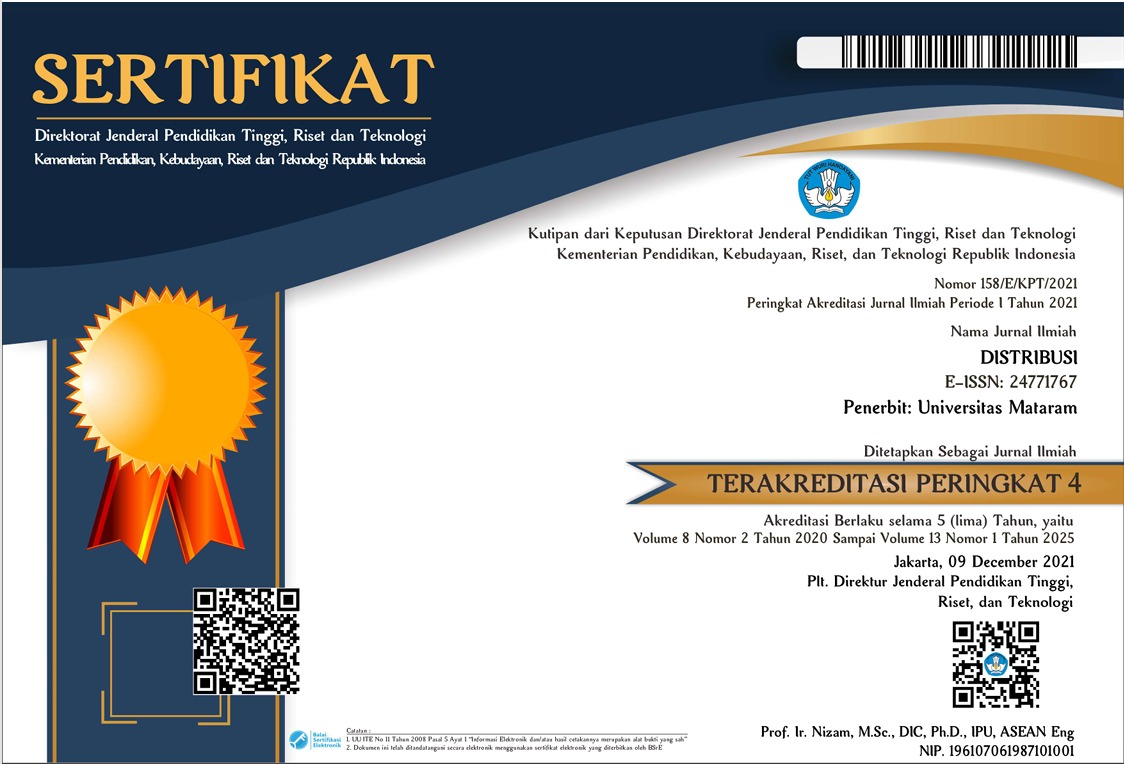PENGEMBANGAN INTEGRASI TAM DENGAN FLOW THEORY DAN MOBILE APP DESIGN QUALITY PADA PENGGUNA E-COMMERCE DI BALI
DOI:
https://doi.org/10.29303/distribusi.v12i1.422Keywords:
Niat Untuk Terus Menggunakan, Kualitas Desain Mobile App, Persepsi Kemudahaan Penggunaan, Persepsi Kemanfaatan, Persepsi PengalamanAbstract
Tujuan penelitian ini adalah untuk menguji dan menjelaskan pengaruh persepsi kemudahan penggunaan, persepsi kemanfaatan, dan kualitas desain mobile app terhadap perceived flow (persepsi pengalaman) dan niat untuk terus menggunakan. Populasi penelitian ini adalah konsumen yang menggunakan e-commerce di Bali yang jumlahnya tidak diketahui. Besarnya sampel yang digunakan sebanyak 180 orang dengan metode purposive sampling. Teknik analisis yang digunakan adalah Path Analysis dengan menggunakan SEM-PLS. Hasil penelitian menunjukkan bahwa persepsi kemudahaan penggunaan tidak berpengaruh terhadap niat untuk terus menggunakan, sedangkan persepsi kemanfaatan dan kualitas desain mobile app berpengaruh positif dan signifikan terhadap niat untuk terus menggunakan, dan persepsi kemudahan penggunaan, persepsi kemanfaatan, kualitas desain mobile app berpengaruh positif dan signikan terhadap persepsi pengalaman, serta persepsi pengalaman berpengaruh positif dan signifikan terhadap niat untuk terus menggunakan. Oleh karena itu penting bagi e-commerce di Bali untuk selalu memperhatikan persepsi kemudahaan penggunaan, persepsi kemanfaatan, kualitas desai mobile app dalam rangka meningkatkan persepsi pengalaman dan niat untuk terus menggunakan.
Downloads
References
Christina, Y., and Yasa, N.N.K., (2021), Application of theory of planned behavior to study online booking behavior, International Journal of Data and Network Science, 5 (3), 1-15
Dewi, AP, Yasa, N.N.K., Setiawan, PY., (2017), Integrasi TAM dan ECM dalam menjelaskan niat membeli kembali produk fashion secara online di Kota Denpasar, E-Jurnal Ekonomi dan Bisnis Universitas Udayana, 6 (06)
Dewi, CRA., Yasa, N.N.K., Giantari, IGAK., Sukawati, TGR., Setiawan, PY., .(2021), The Effect Of Security, Trust And Ease Of Use Towards Repurchase Intentions Mediated By E-Satisfaction On Online Travel Agent, Journal of Advanced Research in Dynamical and Control Systems, 12 (8), 340-354
Fan, L., Gu, J., Suh, Y. and Lee, S. (2012), How to attract Chinese online game users: An empirical study on the determinants affecting intention to use Chinese online games, Asian Journal on Quality, 13 (1), pp. 7-21.
Gao, L., & Bai, X. (2014). An empirical study on continuance intention of mobile social networking services: Integrating the IS success model, network externalities and flow theory. Asia Pacific Journal of Marketing and Logistics, 26 (2), 168–189. doi:10.1108/APJML-07- 2013-0086
Hadi, S. H., Permanasari, A. E., Hartanto, R., Sakkinah, I. S., Sholihin, M., Sari, R. C., & Haniffa, R. (2022). Developing augmented reality-based learning media and users’ intention to use it for teaching accounting ethics. Education and Information Technologies, 27(1), 643-670.
Haq, I. U., & Awan, T. M. (2020). Impact of e-banking service quality on e-loyalty in pandemic times through interplay of e-satisfaction. Vilakshan-XIMB Journal of Management.
Hossain, M. S., Zhou, X., & Rahman, M. F. (2018). Examining the impact of QR codes on purchase intention and customer satisfaction on the basis of perceived flow. International Journal of Engineering Business Management, 10, 1847979018812323.
Hsiao, K.-L., Lin, K.-Y., Wang, Y.-T., Lee, C.-H. and Zhang, Z.-M. (2019), Continued use intention of lifestyle mobile applications: the Starbucks app in Taiwan, The Electronic Library, 37 (5), pp. 893-913.
Humida, T., Al Mamun, M. H., & Keikhosrokiani, P. (2022). Predicting behavioral intention to use e-learning system: A case-study in Begum Rokeya University, Rangpur, Bangladesh. Education and information technologies, 27(2), 2241-2265.
Kim, M. J., Chung, N., Lee, C. K., & Preis, M. W. (2016). Dual-route of persuasive
communications in mobile tourism shopping. Telematics and Informatics, 33(2),
–308.
Kim, M. J., & Hall, C. M. (2019). A hedonic motivation model in virtual reality tourism: Comparing visitors and non-visitors. International Journal of Information Management, 46, 236-249.
Kumar, A., Adlakaha, A., & Mukherjee, K. (2018). The effect of perceived security and grievance redressal on continuance intention to use M-wallets in a developing country. International Journal of Bank Marketing.
Kustiwi, I. A., & Isnalita, I. (2018, July). Trust and purchasing intention in e-commerce: Lazada Indonesia. In International Conference of Communication Science Research (ICCSR 2018) (pp. 28-32). Atlantis Press.
Lee, K., Haque, A., Maulan, S., & Abdullah, K. (2019). Determining intention to buy air e-tickets in Malaysia. Management Science Letters, 9(6), 933-944.
Liu, Y., Liu, D., Yuan, Y. and Archer, N. (2018), Examining situational continuous mobile game play behavior from the perspectives of diversion and flow experience, Information Technology & People, 31 (4), pp. 948-965.
Lu, A., Deng, R., Huang, Y., Song, T., Shen, Y., Fan, Z., & Zhang, J. (2022). The roles of mobile app perceived usefulness and perceived ease of use in app-based Chinese and English learning flow and satisfaction. Education and Information Technologies, 1-22.
Martins, J., Costa, C., Oliveira, T., Gonçalves, R., & Branco, F. (2019). How smartphone advertising influences consumers' purchase intention. Journal of Business Research, 94, 378-387.
Matute-Vallejo, J., & Melero-Polo, I. (2019). Understanding online business simulation games: The role of flow experience, perceived enjoyment and personal innovativeness. Australasian Journal of Educational Technology, 35(3).
Miandari, DD GAK., Yasa, N.N.K., Wardana, IM., Giantari, IGAK., (2021), Application of Technology Acceptance Model to Explain Repurchase Intention in Online Shopping Consumers, Webology, 18 (1), 247-262
Moon, H.Y. and Lee, B.Y. (2022), Self-service technologies (SSTs) in airline services: multimediating effects of flow experience and SST evaluation, International Journal of Contemporary Hospitality Management, 34 (6), pp. 2176-2198.
Nandi, S., Nandi, M.L. and Khandker, V. (2021), Impact of perceived interactivity and perceived value on mobile app stickiness: an emerging economy perspective, Journal of Consumer Marketing, 38 (6), pp. 721-737.
Park, G., Chen, F., and Cheng, L. (2021). A study on the millennials usage behavior
of social network services: effects of motivation, density, and centrality on
continuous intention to use. Sustainability 13:2680. doi: 10.3390/su13052680.
Prayudi, IG., Sukaatmadja, IPG., Yasa, Giantari, (2022), The Role of Trust in Mediation the Effect of Perception of Ease of Use and Perception of Usefulness on Intention to Re-Using the Mobile Banking Service, International Research Journal of Management, IT & Social Sciences, 9 (4).
Rahmayanti, P.L.D., Widagda, IGNJA, Yasa, N.N.K., Giantari, IGAK., Martaleni, Buana, D S, (2021), Integration of technology acceptance model and theory of reasoned action in pre-dicting e-wallet continuous usage intentions.
Sarkar, S., & Khare, A. (2019). Influence of expectation confirmation, network externalities, and flow on use of mobile shopping apps. International Journal of Human–Computer Interaction, 35(16), 1449-1460.
Vărzaru, A. A., Bocean, C. G., Rotea, C. C., & Budică-Iacob, A. F. (2021). Assessing antecedents of behavioral intention to use mobile technologies in e-commerce. Electronics, 10(18), 2231.
Wu, L., Chiu, M. L., & Chen, K. W. (2020). Defining the determinants of online impulse buying through a shopping process of integrating perceived risk, expectation-confirmation model, and flow theory issues. International Journal of Information Management, 52, 102099.
Zhao, H., & Khan, A. (2022). The students’ flow experience with the continuous intention of using online english platforms. Frontiers in Psychology, 12, 6354.
Downloads
Published
How to Cite
Issue
Section
License
Copyright (c) 2024 I Gst. Ngr. Jaya Agung Widagda, I Gusti Ayu Dewi Adnyani, Putu Laksmita Dewi Rahmayanti, Emilia Septiani

This work is licensed under a Creative Commons Attribution-ShareAlike 4.0 International License.
Penulis yang naskahnya diterbitkan menyetujui ketentuan sebagai berikut:
- Hak publikasi atas semua materi naskah jurnal yang diterbitkan/dipublikasikan dalam situs Jurnal DISTRIBUSI ini dipegang oleh dewan redaksi dengan sepengetahuan penulis (hak moral tetap milik penulis naskah).
- Ketentuan legal formal untuk akses artikel digital jurnal elektronik ini tunduk pada ketentuan lisensi Creative Commons Attribution-ShareAlike (CC BY-SA), yang berarti Jurnal DISTRIBUSI berhak menyimpan, mengalih media/format-kan, mengelola dalam bentuk pangkalan data (database), merawat, dan mempublikasikan artikel tanpa meminta izin dari Penulis selama tetap mencantumkan nama Penulis sebagai pemilik Hak Cipta.
- Naskah yang diterbitkan/dipublikasikan secara cetak dan elektronik bersifat open access untuk tujuan pendidikan, penelitian, dan perpustakaan. Selain tujuan tersebut, dewan redaksi tidak bertanggung jawab atas pelanggaran terhadap hukum hak cipta.









